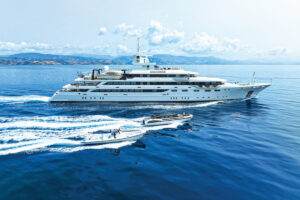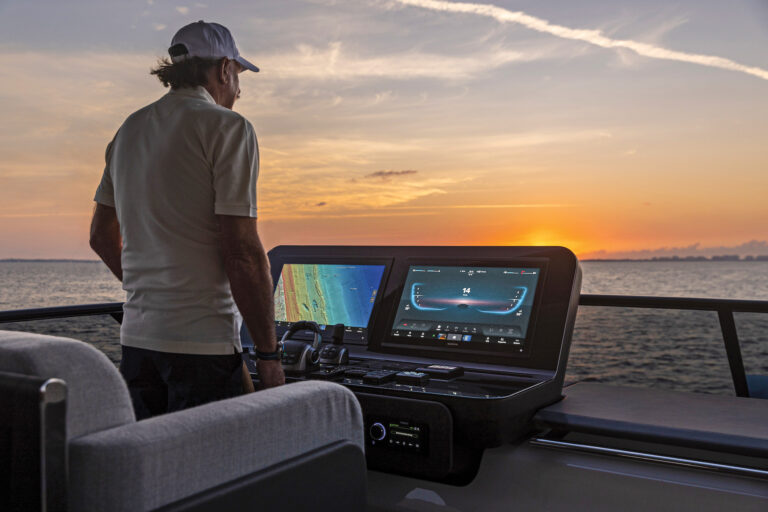To starboard lay the bold, lunar shores of Baja, Mexico, ruddy by the light of another dying day. Twin Lugger diesels, humming in throaty chorus, propelled our N37 trawler yacht through the calm, wine-dark Pacific.
I looked ahead, daydreaming of yesterday’s thrill and that night’s promise-gray whales and bottles of beer. My crew listened to the start of the Super Bowl over AM radio from San Diego.
To tell the truth, he and I were road-weary. We were four days out of Cabo San Lucas on the last leg of a 4,600-mile delivery from Jacksonville, Florida.
“Charlie,” I said, “Ensenada will cure this funk-you’ll see.”
As we steamed through Ensenada’s breakwaters and beheld that great, big Mexican flag waving languidly over the waterfront, this East Coast gringo felt like he was coming home. Over the years, I’d developed real affection for this city so far from my native New England.
Soon we sat at Hussong’s Cantina, celebrating a successful voyage with margaritas and cerveza, poured by an all-male corps of bartenders. Mariachis belted out old favorites as tables of young, neatly dressed Mexicans sang along like family. A faint aroma of kerosene (preservative for the ancient planked floor, I assumed) hung in the air, and 40-year-old caricatures of bar patrons grinned from the walls like so many happy ghosts.
If those walls could talk, we might know what German prospector John Hussong was thinking in 1892 when he opened a cantina in a dusty, isolated corner of Mexico. Could he have known that a city of a quarter-million people would rise around it? What would those walls say about Clark Gable and Carole Lombard and the other 1930s-era stars who drove there for an escape?
Hussong’s is a grittier West Coast version of Sloppy Joe’s saloon in Key West, and its logotype is as world-traveled as that of any Black Dog. Descendants of John Hussong wisely put their whizzy merchandising division in a modern building down the street, thus maintaining the shopworn cantina’s boozy purity.
The last weekend of April, Hussong’s and the many bars of Ensenada overflow with rambunctious participants of the Newport-Ensenada Race. This 56-year-old event (now called the Tommy Bahama Newport to Ensenada Race) is touted as the world’s biggest international sailboat race, pitting more than 450 boats (and at least as many egos) against each other in a 125-mile run from Newport Beach, California. Ensenada is also the terminus for various motorcycle and desert-buggy races, for which the Baja peninsula is famous.
All this said, Ensenada is busy reinventing itself as it grows and prospers, distancing itself from its rough-hewn frontier past as it begins to evolve into a-dare I say it-café society. Cruise ships call, as do yachts seeking first-class workmanship. Mom-and-pop cruisers get their introduction to Latin America here, a gradual immersion that softens inevitable culture shock and prepares them for difficulties southward.
Mariners can stop at one of Ensenada’s five marinas, which have a total of nearly 600 slips. Three of these-Baja Naval, Marina Coral and Cruiseport Village Marina-are first-class facilities. Baja Naval is also a boatyard California yachtsmen regard highly for its workmanship, integrity and reasonable rates.
Ensenda’s proximity to San Diego and its international airport, 90 minutes away on a road “plenty wide and fast,” as Lyle Lovett sings in “The Road to Ensenada,” also makes the stop attractive.
Back in Boston, my crew toils as a chef, and to him I extolled Ensenda as a food and wine destination-with a fish market the likes of which have all but disappeared from the North American landscape. Fresher fish, shrimp and shellfish you will not find, nor at better prices. Baja’s interior is cattle country, and I’ve seen tomato fields here that extend for miles. Combine fresh ingredients with Mexico’s rich and varied culinary traditions and you get some of the finest dining you’ll find anywhere.
Ensenada’s most famous culinary contribution, though, is one of its simplest: the fish taco. These savory wraps are sold in dining stalls next to the fish market and from wagons at intersections throughout the city. Viva cilantro!
Getting there
Ensenada is a straightforward 60 nautical miles from San Diego. Set a course to take you inside the Coronado Islands, 5 to 8 miles from the mainland. Following the coast will take you directly into the Bay of All Saints. You will pass the Isla de Todos Santos islands to starboard, noting the red-striped lighthouse. Approaching from the south, take the islands to port, staying well off the ledges that extend from Punta Banda.
Landmarks include two red container cranes on the seaport’s west jetty and a pinkish high-rise hotel. Marina Coral, with its own riprap jetties, is 23/4 miles northwest of port. Other marinas are inside Ensenada’s breakwaters.
Waypoints: Isla de Todos Santos northwest light: 31o48.75’N, 116o48.7’W. Entrance to Ensenada Harbor: 31o50.23’N, 116o37.59’W.
Charts: DMA charts 21104 and 21021, also available through Waterproof Charts
Cruising guides: Charlie’s Charts of the West Coast of Mexico, by Charles E. Wood, includes sketch charts. Volume 1 of Baja Boater’s Guide: The Pacific Coast includes sketch charts and aerial photos. Cruising Ports: Florida to California via Panama, by captains Pat and John Rains, includes sketch charts.
Mexico is said to have seven major wineries, and all of its vineyards are within an hour of the city. Their names include L.A. Cetto, Monte Xanic and Domecq, all of which offer tours and tastings like their counterparts north of the border. Were I southbound, I would stock the ship’s wine locker with caseloads of these labels.
Ensenada is also an excellent shopping destination, full of high-end shops catering to the cruise-ship crowds. The place overflows with silver jewelry and craftwork. I’m a sucker for polished carvings made from ancient ironwood trees, one of the few woods too dense to float. For provisioning, you’ll find U.S.-style supermarkets with many of the major brands you’re used to. Vendors, except those at supermarkets, expect you to negotiate for lower prices; they see walking away as another bargaining tactic, so don’t hesitate to use it as such.
Ensenada is the American gateway to destinations south, including the vast Sea of Cortez. Even those who command a well-found vessel-and can commit the time-may be deterred by the 700 miles of rugged, empty coast separating Ensenada from Cabo San Lucas. Unfortunately, the Mexican government’s initiatives to establish a series of fuel stops and cruising facilities have been unsuccessful, due in part to budget realities and opposition from environmentalists. Onerous and archaic regulations governing foreign yachts do not help matters.
Here, Ensenada can help. For a small fee the major marinas will handle your government paperwork. Also, the city is an excellent staging area for landward exploration of the Baja peninsula; it’s a secure and inexpensive place to leave your boat while you head off to reconnoiter the Sea of Cortez, a one- or two-day drive through mountains, depending on your route.
As you drive across that last ridge, and the Bay of Angels unfolds before you as you look down at a swath of inky blue rimmed by extinct volcanoes and thick with whales, your reaction may be as visceral as was mine. You may well decide that the adventure of a lifetime is worth the hardship.
While You’re There
PLACES TO STAY
Cruiseport Village Marina (011) 52 646 178 8806
Coral Hotel and Marina from U.S.: (800) 862-9020 from Mexico: (526) 175-0000 marina@hotelcoral.com www.hotelcoral.com
Hotel Mision Santa Isabel (011) 52 646 178 3616 hmision@telnor.net misionsantaisabel@yahoo.com
RESTAURANTS
El Rey Sol (888) 311-6871 ext. 100 (011) 52 6 178 1601 elreysol@correo.baja.com
Laja (011) 52 646 155 2556 laja@quatrodesign.com
THINGS TO DO
Hire a cab and head out for an afternoon tour of the L.A. Cetto Winery, 45 minutes from Ensenada in the Guadalupe Valley. (011) 52 646 155 2264; www.lacetto.com.mx
Take a trip south of Ensenada to La Bufadora, or “the blowhole.” The 45-minute ride to Punta Banda affords some dramatic coastal views. When the Pacific develops big swells, La Bufadora funnels them into sky-high geysers. If that doesn’t tickle your fancy, be sure to check out the gewgaw souvenir booths lining the path to the popular blowhole.









